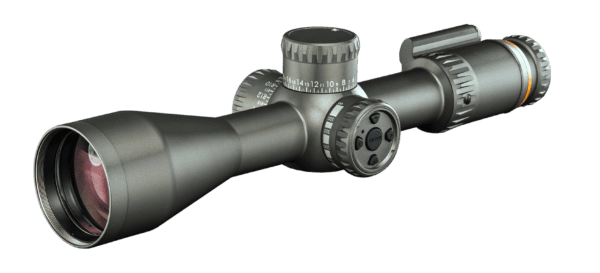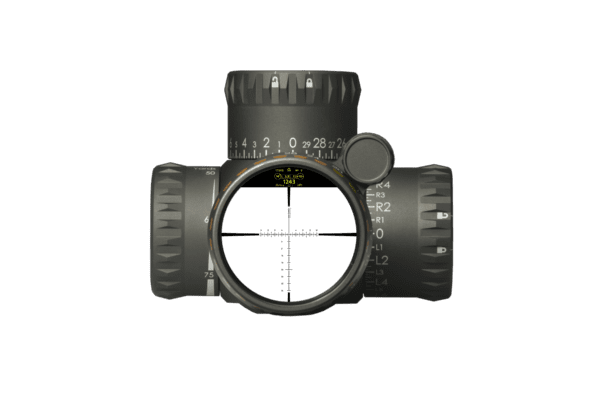From the guys who brought us the powerful and quite badass Gunwerks G7 BR2 rangefinder comes a riflescope with ballistics solving power built right in. Angle, compass direction, temperature, and pressure are all accounted for by the scope, and a display visible above the reticle shows what range the turret is dialed for. Likewise, windage adjustments are displayed inside the scope and are corrected for spin drift and other variables. Revic Optics’ press release on this 4.5-28×56 scope follows . . .
Revic Optics Introduces PMR 428 Riflescope
Cody, WY – June 16, 2017 – Revic Optics has introduced its first riflescope product: the PMR 428. This truly innovative 4.5-28×56 riflescope delivers everything any serious long-range shooter could need. Using the Revic Optics ballistic app, the shooter uploads all ballistic data to the riflescope via a Bluetooth connection. In the field, once the shooter has ranged their target, they simply adjust the elevation turret to the target distance and it activates the “virtual BDC.” The “vBDC” feature then, taking into account the ballistic data previously uploaded, performs a real time ballistic calculations and automatically corrects the distance for inclination, compass direction, temperature and pressure. Additionally, the total windage correction feature adjusts for information derived from heading, speed inputs and spin drift.
”The PMR 428 offers a sophisticated, but unbelievably simple way to compensate for ballistics. Just dial the turret until the target distance is displayed, all the angles and environmental data are measured on the device and ballistic correction happens faster than you can dial the turret! As our premier product, it sets the tone for an exciting future!” says Aaron Davidson, CEO of Revic Optics.
The 34mm tube diameter PMR 428 has an elevation adjustment range of 80 moa and a windage adjustment range of 50 moa. The elevation adjustment per revolution is 30 moa.
Due to Revic Optic’s commitment to deliver the best products for the best price, the PMR 428 riflescope, like all future Revic Optics products, will only be available directly through Revic Optics. The direct-to-consumer price will be $2,750. To find out more, go to www.revicoptics.com.
About Revic Optics: Built on the core belief of not compromising quality and delivering the best optics products for the best prices, Revic Optics is redefining the optics business. Going directly to the consumer, they eliminate the unnecessary layers and costs of “traditional” sales distribution channels, thus allowing them to invest more into their products. The Revic Optics engineering team partners with the best suppliers, to produce the best products, with the best features, from the highest-quality materials for the lowest price possible. To find out more, visit www.revicoptics.com.






That’s actually not bad for a high quality piece of glass. I’d be interested in seeing how it shoots.
I predict this is the new future of all scopes. Soon all the high end scopes will have full built in electronics package.
That may not be as easy as it sounds powering that sucker and keeping it working will be a stone cold bitch.
Powered rails and a battery in the grip or buttstock.
Plus it’s a fully-functional, normal scope should the battery crap out and you aren’t carrying a spare…
The next step is integrating the laser rangefinder into the scope. I think the step after that will be some sort of LED system that allows your aiming point to be projected onto the field of view inside the scope. So instead of having to dial in your adjustments or having to read the reticle tape to figure out the hold, a precise little red dot illuminates at the correct point for the distance you just measured plus your ballistics profile and all the atmospherics the scope measures. Heck, if that dot could move left or right as well to account for wind, spin drift, coriolis, etc that would be even more badass (rather than just up and down the elevation axis). Push the button to range your target, the scope does the computing, and a red dot appears in your view. Put the red dot on the target, pull the trigger.
That is a cool scope. To your idea about future scopes, I seem to get a wrong read off of my range finder occasionally, I guess that would be less likely with a 28x scope mounted on a rifle, but still a possibility.
Some of the fancier range finders like the Gunwerks one mentioned allow you to choose what “hit” it displays range for, which is more and more helpful as the ranges get longer and the laser beam spreads out. You can tell it to display the closest return in its spread, the middle, or the farthest, or tell it to return the distance to the strongest target hit inside the scan area, etc. Example: there’s a copse of trees between you and the deer that you can see through them. Choose “far” to tell the range finder to ignore the trees and return the range for the deer.
Isn’t this that a burris eliminator, then?
Sounds like you are describing the Tracking Point system in manual firing mode.
Which, of course, brings up an interesting question. Will the future of “smart scopes” be conventional optical scopes augmented with electronics (as this design is heading toward), or what amount to shock-proof long-range video cameras with lots of image processing, and a miniature display where the eyepiece usually is (a-la Tracking Point)?
So it’s like a video game now and basically tells you how to hit the target.
Damn, and I thought the CONX Kestrel package was cool.
There was a time when shooters used their brains and memory (and handwritten DOPE) to figure out how to hit targets at distance. Now we need machines to do our thinking for us.
And what’s the payoff? Outside of combat situations, I can’t think of any. Do we want bragging rights as to who has the best handheld computer? Are we so lazy that we can’t stalk that big elk and instead we have to shoot it from a mile and a half away?
I’d prefer to shoot the gun myself, thank you. Electronics will be the death of long distance shooting.
Experienced shooters already almost never miss due to distance hold anymore. The advent of laser rangefinders ended that. This scope just integrates what you’d get with a rangefinder plus DOPE sheet or ballistics program — it’s all your DOPE data built-in plus automatic adjustment for angle and density. But…we’ll continue to miss due to wind. Judging what the wind is doing and how it’ll affect the bullet is still the learned art you speak of.
BlueTooth it to a Kestrel and windage problems won’t go away but will be significantly reduced.
You can do that with this scope and the Gunwerks range finder mentioned at top. But…depending on range and terrain, obviously the wind where you’re at may not have much to do with the wind between you and the target. Even in a huge open field, the wind a few feet off the ground where you’re likely to measure is often slower than higher up where the bullet spends most of its flight (long range, where you’re arcing the thing in). I find a wind meter helpful but still often fail to account for all of the variables introduced by terrain or fail to condense it all down into an average direction and speed to hold for. After seeing a few guys who are truly skilled at this, there’s an art to it that comes from experience. I think you’d have to fly a drone down the ballistic trajectory collecting wind data the whole way to be able to computerize a solution 😉 (and it would probably be stale by the time you fired anyway haha)
Jesus. You spoiled kids these days. Optics? You’re no better than my great grandson, too fancy for iron sights like his pappy used. And even his pappy (my worthless grandson), using brass-cased centerfire ammunition, apparently he’s too good for trustworthy solid black powder like HIS dad always used. Though I tell you, I WAS mighty disappointed in my son when he got one of those fancy high-tech firearms; I guess he’s too good for the old bow and arrow I always use, kids these days, so lazy. Then again, now that I think about it, my daddy always called me a lazy lackwit for using one of those new-fangled bows and arrow, instead of a sharpened stick and atlatl like he always used, or the big rock his daddy always used… so I guess now that I think about it, drawing arbitrary lines in the sand as to what kind of technology is “acceptable” to use (that always coincidentally gets drawn at the exact level that the person drawing it uses) is maybe completely asinine and hypocritical?
This is the best comment regarding tech haters in the history of all internet
Isn’t this a step down from TrackingPoint’s solution?
I like it. A designated laser rangefinder like the Burris Eliminator III without the hideous looks will be a nice additional option. Although the Gunwerks BR2 is such a great rangefinder that you couldn’t put that capability into a scope for awhile. I want a 2,500 yard BR2, but can’t afford it for awhile. I think the Burris maxes out at 1200 yards.
The ballistics program computing power and options built into Gunwerks make it really awesome. For one without ballistics computing that just spits out a distance, it’s hard to beat SIG. For example, the KILO2200 ranges to two miles for $499. There’s also the KILO1250 that can range to 1,600 yards on a reflective target (like 750 on a deer) for $299 or the KILO2400 with all the nifty built-in ballistics and environmental calculating ability for $1,499. Some debate, though, if its ballistics computing is as accurate as the Gunwerks BR2.
Thanks for that, I’ll look into the Sig stuff.
You don’t have to fly a drone down range to measure wind. Doppler radar could do it.